Healthcare Law: Patient Protection and Affordable Care Act Analysis
VerifiedAdded on 2022/08/26
|5
|1567
|19
Report
AI Summary
This report examines the impact of healthcare laws in the United States, with a specific focus on the Patient Protection and Affordable Care Act of 2010. It discusses how these laws have evolved to align with best practices, improve patient-centered care, and provide financial support. The report highlights the effects on nursing practice, emphasizing the importance of evidence-based guidelines, collaboration among healthcare professionals, and pay-for-performance strategies. It also addresses the role of nursing leadership, health information technology, and future trends in healthcare delivery. The report concludes by emphasizing the importance of understanding the expanded range of diseases, and the need for continuous improvement in patient-centered care within the framework of healthcare law.
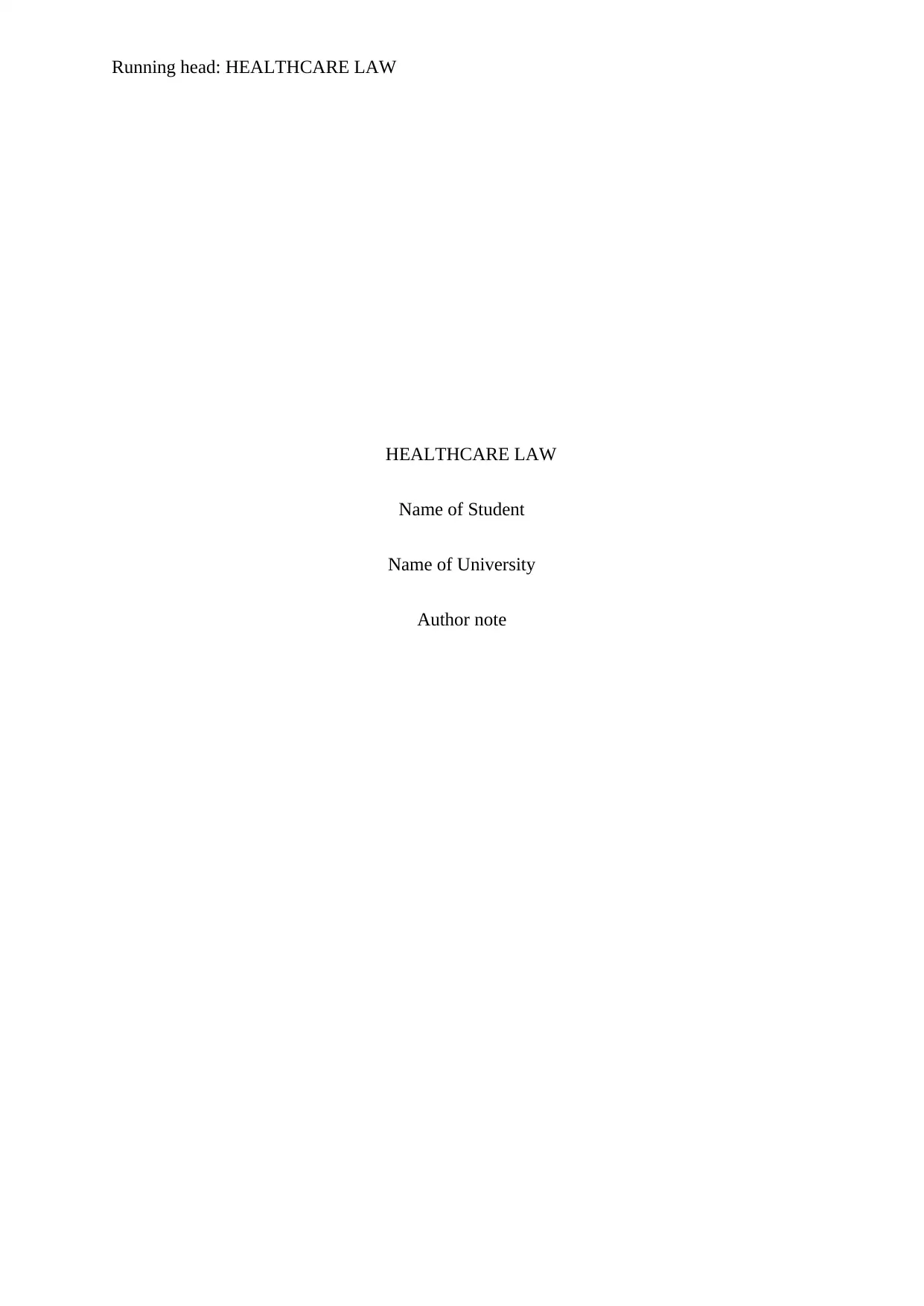
Running head: HEALTHCARE LAW
HEALTHCARE LAW
Name of Student
Name of University
Author note
HEALTHCARE LAW
Name of Student
Name of University
Author note
Paraphrase This Document
Need a fresh take? Get an instant paraphrase of this document with our AI Paraphraser
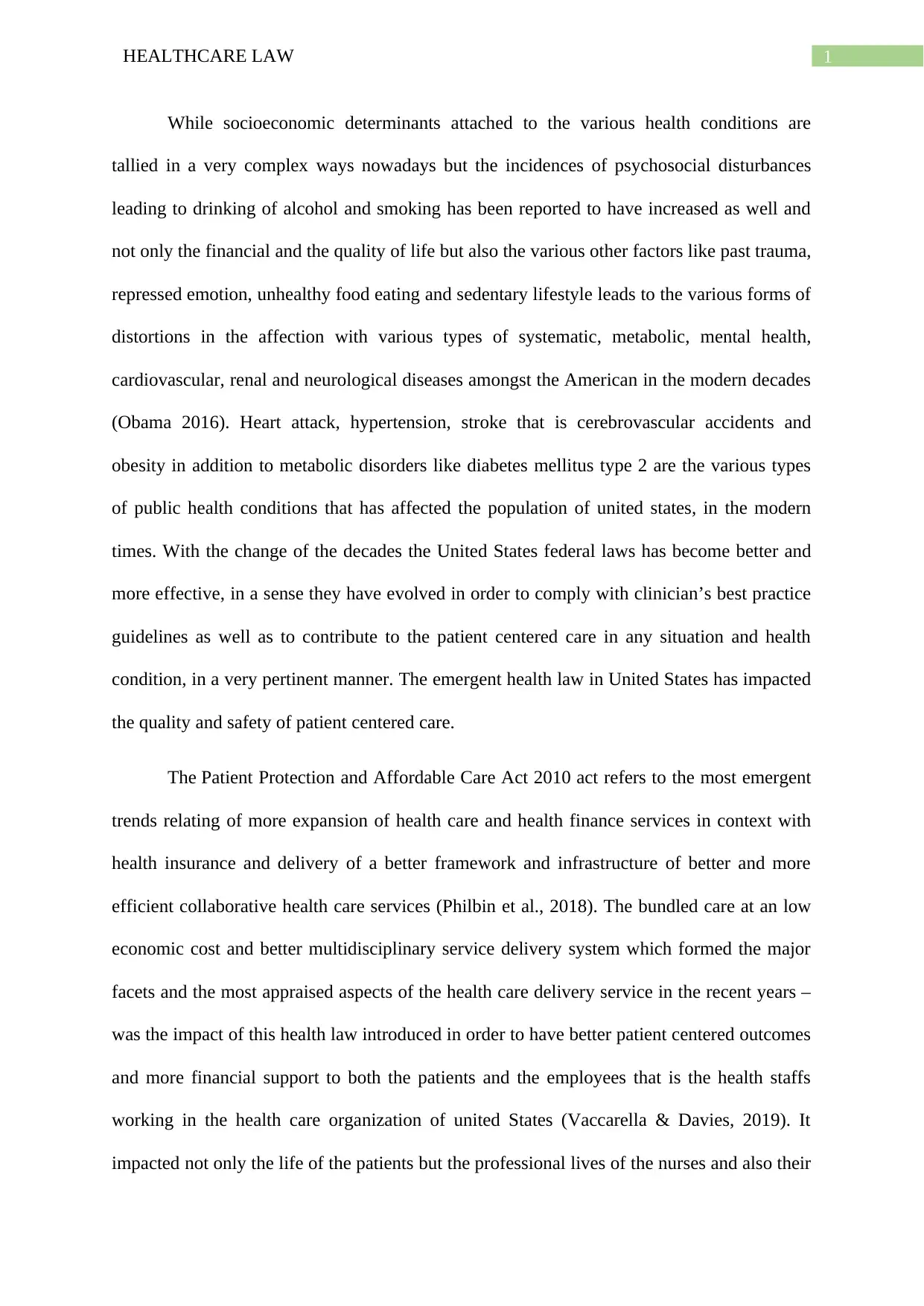
1HEALTHCARE LAW
While socioeconomic determinants attached to the various health conditions are
tallied in a very complex ways nowadays but the incidences of psychosocial disturbances
leading to drinking of alcohol and smoking has been reported to have increased as well and
not only the financial and the quality of life but also the various other factors like past trauma,
repressed emotion, unhealthy food eating and sedentary lifestyle leads to the various forms of
distortions in the affection with various types of systematic, metabolic, mental health,
cardiovascular, renal and neurological diseases amongst the American in the modern decades
(Obama 2016). Heart attack, hypertension, stroke that is cerebrovascular accidents and
obesity in addition to metabolic disorders like diabetes mellitus type 2 are the various types
of public health conditions that has affected the population of united states, in the modern
times. With the change of the decades the United States federal laws has become better and
more effective, in a sense they have evolved in order to comply with clinician’s best practice
guidelines as well as to contribute to the patient centered care in any situation and health
condition, in a very pertinent manner. The emergent health law in United States has impacted
the quality and safety of patient centered care.
The Patient Protection and Affordable Care Act 2010 act refers to the most emergent
trends relating of more expansion of health care and health finance services in context with
health insurance and delivery of a better framework and infrastructure of better and more
efficient collaborative health care services (Philbin et al., 2018). The bundled care at an low
economic cost and better multidisciplinary service delivery system which formed the major
facets and the most appraised aspects of the health care delivery service in the recent years –
was the impact of this health law introduced in order to have better patient centered outcomes
and more financial support to both the patients and the employees that is the health staffs
working in the health care organization of united States (Vaccarella & Davies, 2019). It
impacted not only the life of the patients but the professional lives of the nurses and also their
While socioeconomic determinants attached to the various health conditions are
tallied in a very complex ways nowadays but the incidences of psychosocial disturbances
leading to drinking of alcohol and smoking has been reported to have increased as well and
not only the financial and the quality of life but also the various other factors like past trauma,
repressed emotion, unhealthy food eating and sedentary lifestyle leads to the various forms of
distortions in the affection with various types of systematic, metabolic, mental health,
cardiovascular, renal and neurological diseases amongst the American in the modern decades
(Obama 2016). Heart attack, hypertension, stroke that is cerebrovascular accidents and
obesity in addition to metabolic disorders like diabetes mellitus type 2 are the various types
of public health conditions that has affected the population of united states, in the modern
times. With the change of the decades the United States federal laws has become better and
more effective, in a sense they have evolved in order to comply with clinician’s best practice
guidelines as well as to contribute to the patient centered care in any situation and health
condition, in a very pertinent manner. The emergent health law in United States has impacted
the quality and safety of patient centered care.
The Patient Protection and Affordable Care Act 2010 act refers to the most emergent
trends relating of more expansion of health care and health finance services in context with
health insurance and delivery of a better framework and infrastructure of better and more
efficient collaborative health care services (Philbin et al., 2018). The bundled care at an low
economic cost and better multidisciplinary service delivery system which formed the major
facets and the most appraised aspects of the health care delivery service in the recent years –
was the impact of this health law introduced in order to have better patient centered outcomes
and more financial support to both the patients and the employees that is the health staffs
working in the health care organization of united States (Vaccarella & Davies, 2019). It
impacted not only the life of the patients but the professional lives of the nurses and also their
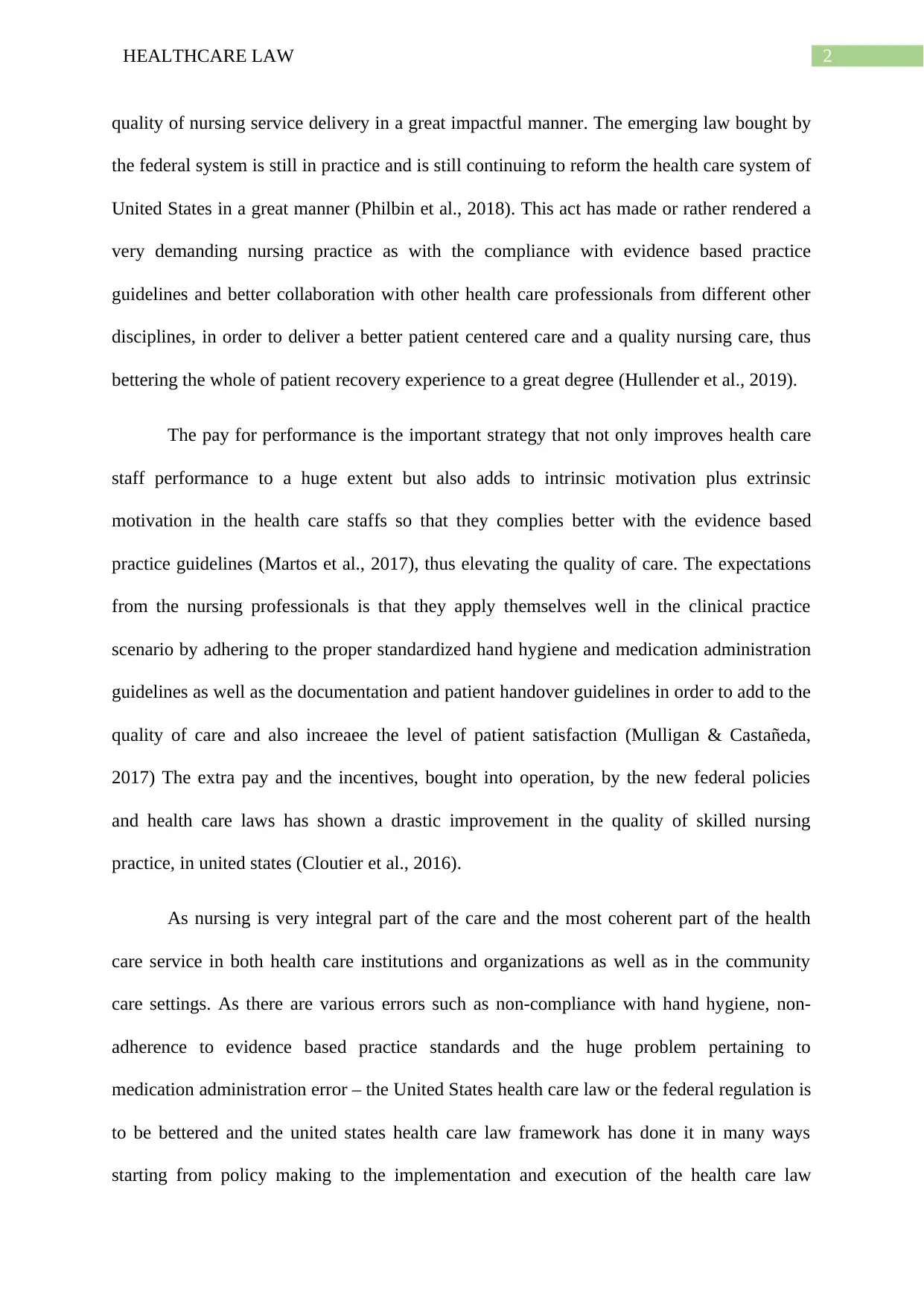
2HEALTHCARE LAW
quality of nursing service delivery in a great impactful manner. The emerging law bought by
the federal system is still in practice and is still continuing to reform the health care system of
United States in a great manner (Philbin et al., 2018). This act has made or rather rendered a
very demanding nursing practice as with the compliance with evidence based practice
guidelines and better collaboration with other health care professionals from different other
disciplines, in order to deliver a better patient centered care and a quality nursing care, thus
bettering the whole of patient recovery experience to a great degree (Hullender et al., 2019).
The pay for performance is the important strategy that not only improves health care
staff performance to a huge extent but also adds to intrinsic motivation plus extrinsic
motivation in the health care staffs so that they complies better with the evidence based
practice guidelines (Martos et al., 2017), thus elevating the quality of care. The expectations
from the nursing professionals is that they apply themselves well in the clinical practice
scenario by adhering to the proper standardized hand hygiene and medication administration
guidelines as well as the documentation and patient handover guidelines in order to add to the
quality of care and also increaee the level of patient satisfaction (Mulligan & Castañeda,
2017) The extra pay and the incentives, bought into operation, by the new federal policies
and health care laws has shown a drastic improvement in the quality of skilled nursing
practice, in united states (Cloutier et al., 2016).
As nursing is very integral part of the care and the most coherent part of the health
care service in both health care institutions and organizations as well as in the community
care settings. As there are various errors such as non-compliance with hand hygiene, non-
adherence to evidence based practice standards and the huge problem pertaining to
medication administration error – the United States health care law or the federal regulation is
to be bettered and the united states health care law framework has done it in many ways
starting from policy making to the implementation and execution of the health care law
quality of nursing service delivery in a great impactful manner. The emerging law bought by
the federal system is still in practice and is still continuing to reform the health care system of
United States in a great manner (Philbin et al., 2018). This act has made or rather rendered a
very demanding nursing practice as with the compliance with evidence based practice
guidelines and better collaboration with other health care professionals from different other
disciplines, in order to deliver a better patient centered care and a quality nursing care, thus
bettering the whole of patient recovery experience to a great degree (Hullender et al., 2019).
The pay for performance is the important strategy that not only improves health care
staff performance to a huge extent but also adds to intrinsic motivation plus extrinsic
motivation in the health care staffs so that they complies better with the evidence based
practice guidelines (Martos et al., 2017), thus elevating the quality of care. The expectations
from the nursing professionals is that they apply themselves well in the clinical practice
scenario by adhering to the proper standardized hand hygiene and medication administration
guidelines as well as the documentation and patient handover guidelines in order to add to the
quality of care and also increaee the level of patient satisfaction (Mulligan & Castañeda,
2017) The extra pay and the incentives, bought into operation, by the new federal policies
and health care laws has shown a drastic improvement in the quality of skilled nursing
practice, in united states (Cloutier et al., 2016).
As nursing is very integral part of the care and the most coherent part of the health
care service in both health care institutions and organizations as well as in the community
care settings. As there are various errors such as non-compliance with hand hygiene, non-
adherence to evidence based practice standards and the huge problem pertaining to
medication administration error – the United States health care law or the federal regulation is
to be bettered and the united states health care law framework has done it in many ways
starting from policy making to the implementation and execution of the health care law
⊘ This is a preview!⊘
Do you want full access?
Subscribe today to unlock all pages.

Trusted by 1+ million students worldwide
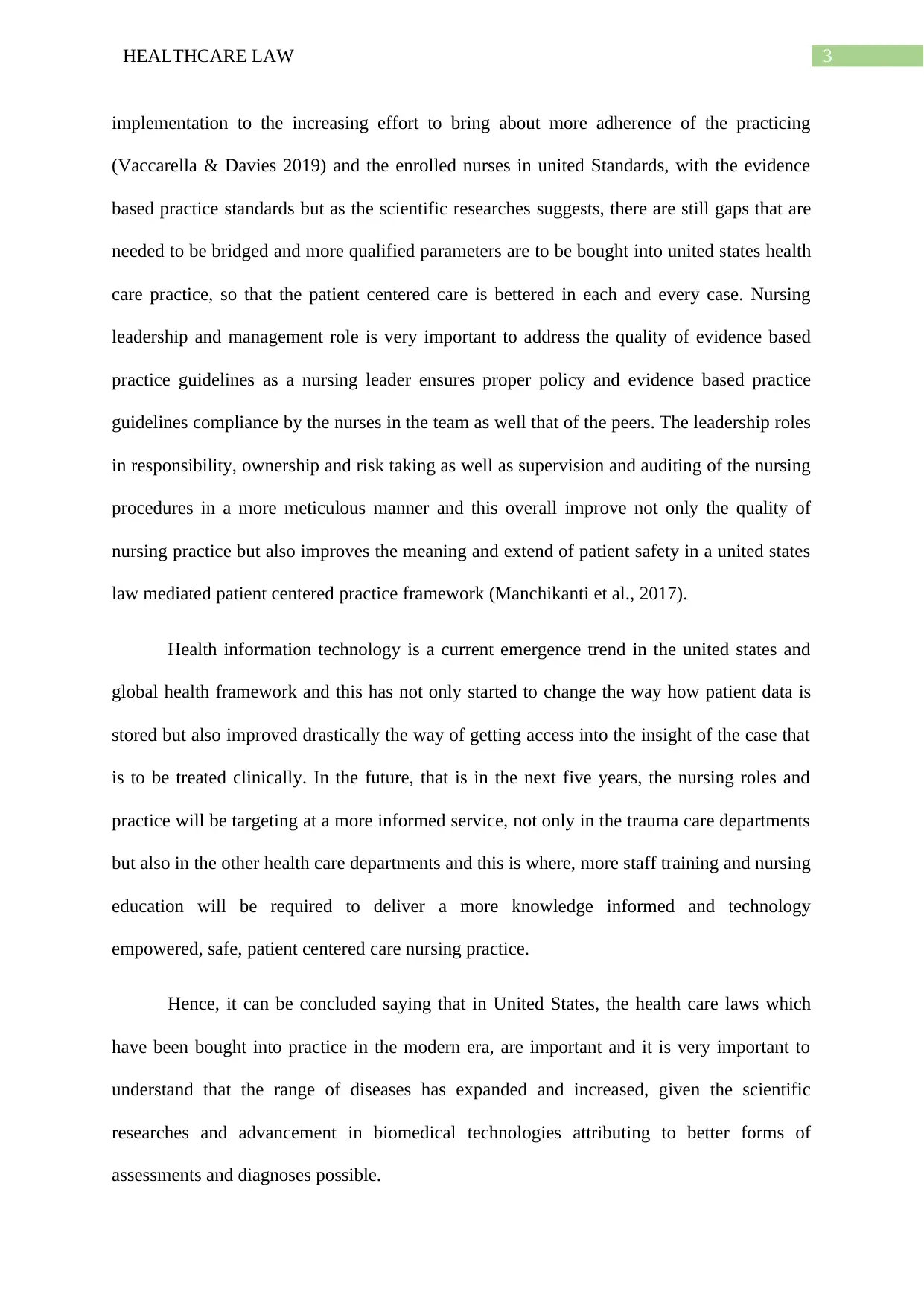
3HEALTHCARE LAW
implementation to the increasing effort to bring about more adherence of the practicing
(Vaccarella & Davies 2019) and the enrolled nurses in united Standards, with the evidence
based practice standards but as the scientific researches suggests, there are still gaps that are
needed to be bridged and more qualified parameters are to be bought into united states health
care practice, so that the patient centered care is bettered in each and every case. Nursing
leadership and management role is very important to address the quality of evidence based
practice guidelines as a nursing leader ensures proper policy and evidence based practice
guidelines compliance by the nurses in the team as well that of the peers. The leadership roles
in responsibility, ownership and risk taking as well as supervision and auditing of the nursing
procedures in a more meticulous manner and this overall improve not only the quality of
nursing practice but also improves the meaning and extend of patient safety in a united states
law mediated patient centered practice framework (Manchikanti et al., 2017).
Health information technology is a current emergence trend in the united states and
global health framework and this has not only started to change the way how patient data is
stored but also improved drastically the way of getting access into the insight of the case that
is to be treated clinically. In the future, that is in the next five years, the nursing roles and
practice will be targeting at a more informed service, not only in the trauma care departments
but also in the other health care departments and this is where, more staff training and nursing
education will be required to deliver a more knowledge informed and technology
empowered, safe, patient centered care nursing practice.
Hence, it can be concluded saying that in United States, the health care laws which
have been bought into practice in the modern era, are important and it is very important to
understand that the range of diseases has expanded and increased, given the scientific
researches and advancement in biomedical technologies attributing to better forms of
assessments and diagnoses possible.
implementation to the increasing effort to bring about more adherence of the practicing
(Vaccarella & Davies 2019) and the enrolled nurses in united Standards, with the evidence
based practice standards but as the scientific researches suggests, there are still gaps that are
needed to be bridged and more qualified parameters are to be bought into united states health
care practice, so that the patient centered care is bettered in each and every case. Nursing
leadership and management role is very important to address the quality of evidence based
practice guidelines as a nursing leader ensures proper policy and evidence based practice
guidelines compliance by the nurses in the team as well that of the peers. The leadership roles
in responsibility, ownership and risk taking as well as supervision and auditing of the nursing
procedures in a more meticulous manner and this overall improve not only the quality of
nursing practice but also improves the meaning and extend of patient safety in a united states
law mediated patient centered practice framework (Manchikanti et al., 2017).
Health information technology is a current emergence trend in the united states and
global health framework and this has not only started to change the way how patient data is
stored but also improved drastically the way of getting access into the insight of the case that
is to be treated clinically. In the future, that is in the next five years, the nursing roles and
practice will be targeting at a more informed service, not only in the trauma care departments
but also in the other health care departments and this is where, more staff training and nursing
education will be required to deliver a more knowledge informed and technology
empowered, safe, patient centered care nursing practice.
Hence, it can be concluded saying that in United States, the health care laws which
have been bought into practice in the modern era, are important and it is very important to
understand that the range of diseases has expanded and increased, given the scientific
researches and advancement in biomedical technologies attributing to better forms of
assessments and diagnoses possible.
Paraphrase This Document
Need a fresh take? Get an instant paraphrase of this document with our AI Paraphraser
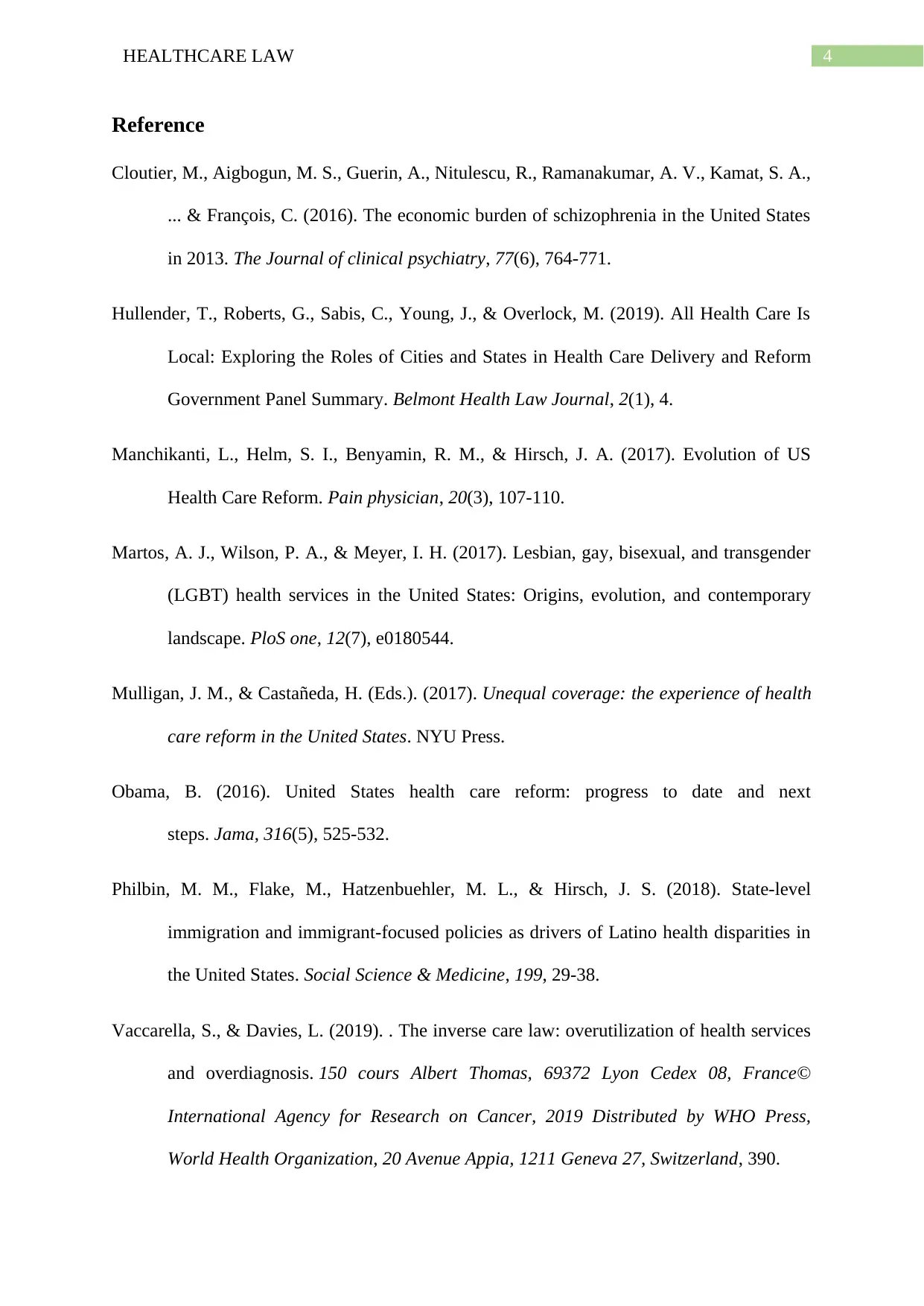
4HEALTHCARE LAW
Reference
Cloutier, M., Aigbogun, M. S., Guerin, A., Nitulescu, R., Ramanakumar, A. V., Kamat, S. A.,
... & François, C. (2016). The economic burden of schizophrenia in the United States
in 2013. The Journal of clinical psychiatry, 77(6), 764-771.
Hullender, T., Roberts, G., Sabis, C., Young, J., & Overlock, M. (2019). All Health Care Is
Local: Exploring the Roles of Cities and States in Health Care Delivery and Reform
Government Panel Summary. Belmont Health Law Journal, 2(1), 4.
Manchikanti, L., Helm, S. I., Benyamin, R. M., & Hirsch, J. A. (2017). Evolution of US
Health Care Reform. Pain physician, 20(3), 107-110.
Martos, A. J., Wilson, P. A., & Meyer, I. H. (2017). Lesbian, gay, bisexual, and transgender
(LGBT) health services in the United States: Origins, evolution, and contemporary
landscape. PloS one, 12(7), e0180544.
Mulligan, J. M., & Castañeda, H. (Eds.). (2017). Unequal coverage: the experience of health
care reform in the United States. NYU Press.
Obama, B. (2016). United States health care reform: progress to date and next
steps. Jama, 316(5), 525-532.
Philbin, M. M., Flake, M., Hatzenbuehler, M. L., & Hirsch, J. S. (2018). State-level
immigration and immigrant-focused policies as drivers of Latino health disparities in
the United States. Social Science & Medicine, 199, 29-38.
Vaccarella, S., & Davies, L. (2019). . The inverse care law: overutilization of health services
and overdiagnosis. 150 cours Albert Thomas, 69372 Lyon Cedex 08, France©
International Agency for Research on Cancer, 2019 Distributed by WHO Press,
World Health Organization, 20 Avenue Appia, 1211 Geneva 27, Switzerland, 390.
Reference
Cloutier, M., Aigbogun, M. S., Guerin, A., Nitulescu, R., Ramanakumar, A. V., Kamat, S. A.,
... & François, C. (2016). The economic burden of schizophrenia in the United States
in 2013. The Journal of clinical psychiatry, 77(6), 764-771.
Hullender, T., Roberts, G., Sabis, C., Young, J., & Overlock, M. (2019). All Health Care Is
Local: Exploring the Roles of Cities and States in Health Care Delivery and Reform
Government Panel Summary. Belmont Health Law Journal, 2(1), 4.
Manchikanti, L., Helm, S. I., Benyamin, R. M., & Hirsch, J. A. (2017). Evolution of US
Health Care Reform. Pain physician, 20(3), 107-110.
Martos, A. J., Wilson, P. A., & Meyer, I. H. (2017). Lesbian, gay, bisexual, and transgender
(LGBT) health services in the United States: Origins, evolution, and contemporary
landscape. PloS one, 12(7), e0180544.
Mulligan, J. M., & Castañeda, H. (Eds.). (2017). Unequal coverage: the experience of health
care reform in the United States. NYU Press.
Obama, B. (2016). United States health care reform: progress to date and next
steps. Jama, 316(5), 525-532.
Philbin, M. M., Flake, M., Hatzenbuehler, M. L., & Hirsch, J. S. (2018). State-level
immigration and immigrant-focused policies as drivers of Latino health disparities in
the United States. Social Science & Medicine, 199, 29-38.
Vaccarella, S., & Davies, L. (2019). . The inverse care law: overutilization of health services
and overdiagnosis. 150 cours Albert Thomas, 69372 Lyon Cedex 08, France©
International Agency for Research on Cancer, 2019 Distributed by WHO Press,
World Health Organization, 20 Avenue Appia, 1211 Geneva 27, Switzerland, 390.
1 out of 5
Related Documents
Your All-in-One AI-Powered Toolkit for Academic Success.
+13062052269
info@desklib.com
Available 24*7 on WhatsApp / Email
![[object Object]](/_next/static/media/star-bottom.7253800d.svg)
Unlock your academic potential
Copyright © 2020–2025 A2Z Services. All Rights Reserved. Developed and managed by ZUCOL.





